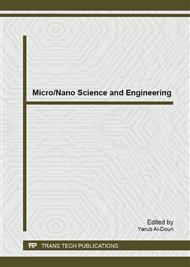p.460
p.464
p.469
p.474
p.481
p.486
p.490
p.495
p.500
Experimental Analysis and FEM Simulation of Novel Finned Loop Heat Pipe
Abstract:
Experiments are conducted to investigate heat transfer characteristics of finned loop heat pipe (FLHP) for heat input range from 20 W to 100 W. The experiments are carried out by manufacturing the FLHP, which the setup consists of a water tank with pump, a flat evaporator, condenser installed with two pieces of fans and air flow fins, two transportation lines (vapor and liquid lines), copper pipe sections for attachment of the thermocouples and power supply. The unique of the current experimental setup is the vapor and liquid lines of FLHP are made of transparent plastic tube to visualize the fluid flow patterns. In this study, the total thermal resistance (Rt) is estimated for both natural and forced convection modes under steady state condition, by varying the air velocity from 2 m/s to 10 m/s. The coolant velocity and heat input to achieve minimum Rt are found out and the corresponding effective thermal conductivity is calculated. The transient temperature distribution in the FLHP is also observed. The experimental observations are verified by simulation using Finite Element Method (FEM). The results reveal that the air velocity and power input have significant effects on the performance of FLHP. As the heat input and air velocity increase, total thermal resistance decreases.
Info:
Periodical:
Pages:
481-485
Citation:
Online since:
April 2014
Price:
Сopyright:
© 2014 Trans Tech Publications Ltd. All Rights Reserved
Share:
Citation:


